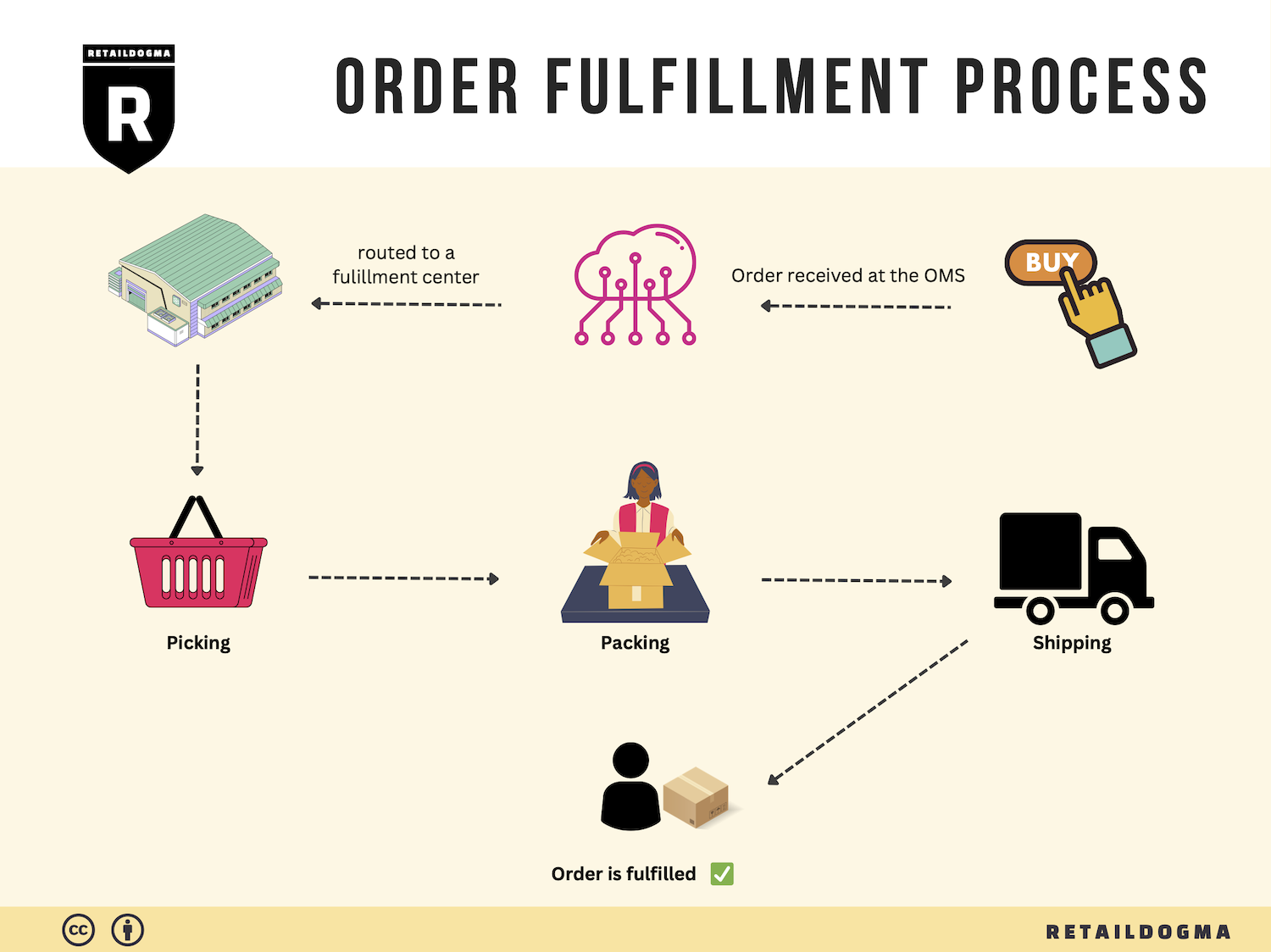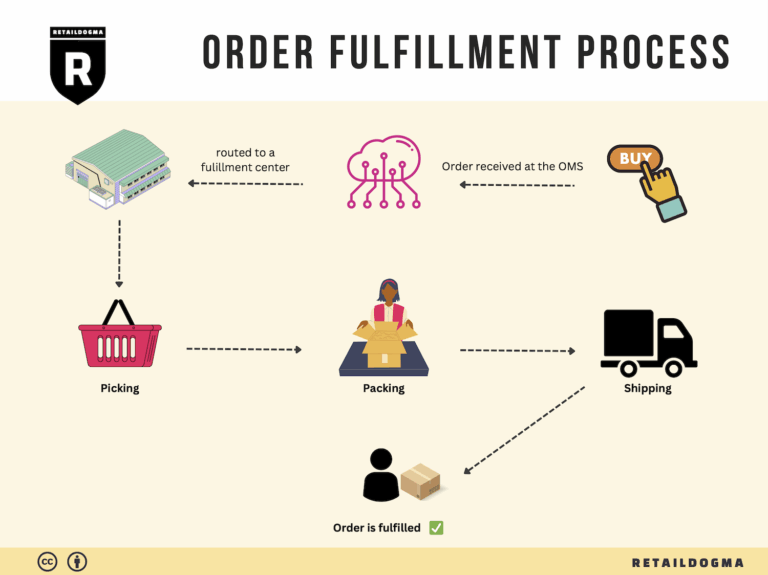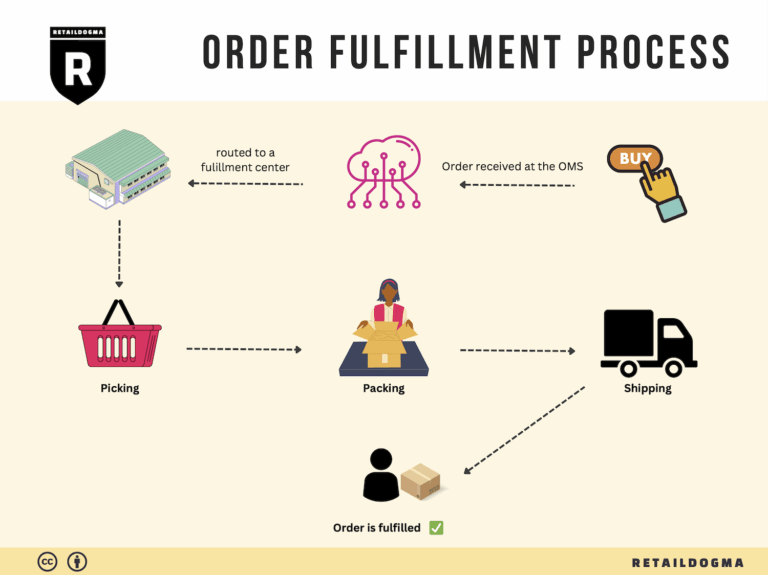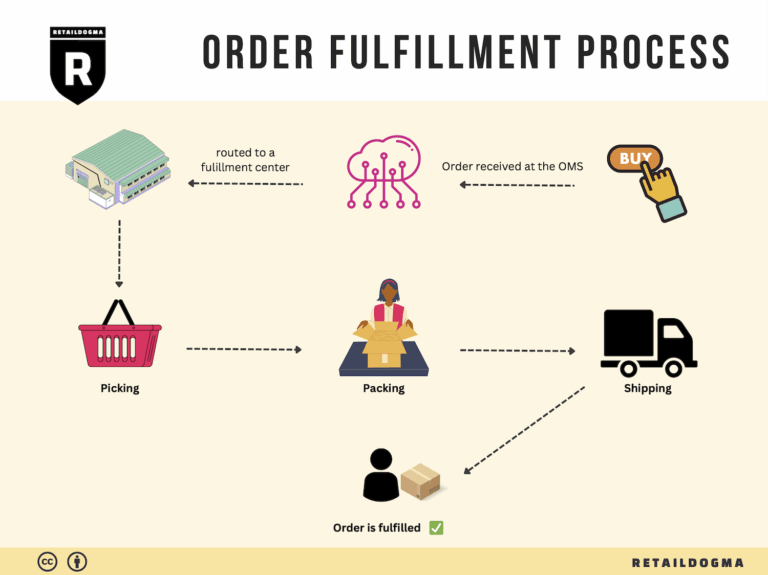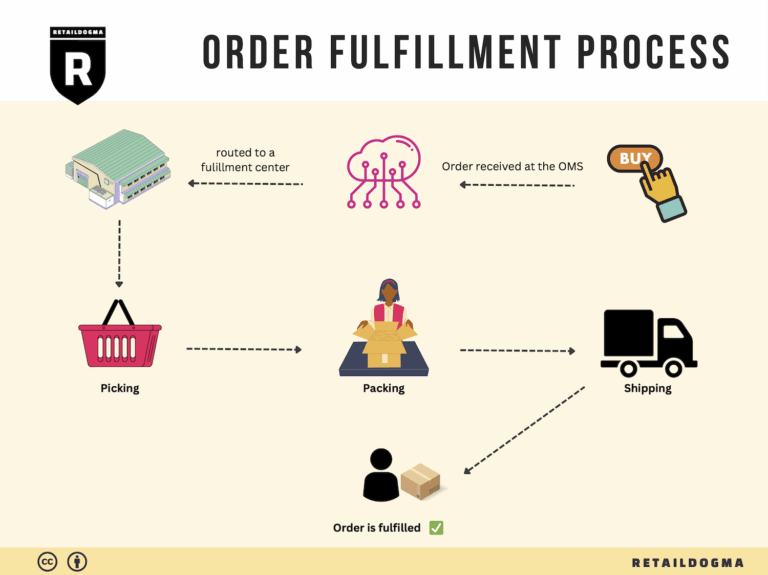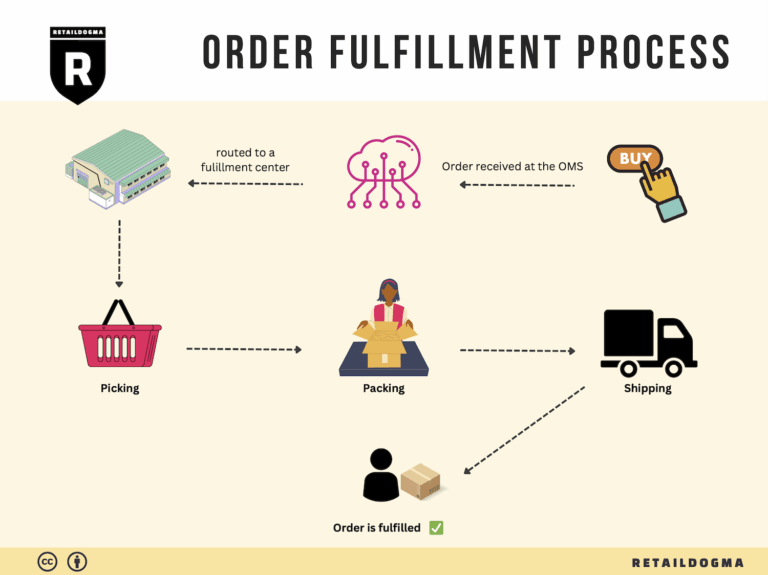How Order Fulfillment Works: A Step-by-Step Guide for Businesses
What is E-commerce Fulfillment? An Introduction for Growing Businesses
Understanding E-commerce Fulfillment
For many growing online businesses, the excitement of increasing sales can quickly turn into a daunting challenge when it comes to packing and shipping orders. As orders multiply, so do the complexities associated with fulfilling them efficiently. The process of e-commerce fulfillment is essential to ensuring that customers receive their products on time and in good condition, but it can be overwhelming without a solid strategy.
E-commerce fulfillment refers to the entire process of getting a product from the warehouse to the customer’s doorstep. This includes inventory management, order processing, packing, shipping, and handling returns. Understanding this process is crucial for any business aiming to scale its operations while maintaining customer satisfaction.
In this guide, we will explore the various fulfillment models available to online retailers, including Third-Party Logistics (3PL) and Fulfillment by Amazon (FBA). Each model has its pros and cons, and understanding them can help you choose the best fit for your business needs. We will also delve into the core services that fulfillment partners typically offer, such as inventory storage, order picking and packing, shipping logistics, and customer service.
Choosing the right fulfillment partner can be a game-changer for your business. We’ll provide practical advice on what to look for in a partner, including their technology capabilities, scalability, and the range of services they provide. Understanding the pricing structures of different fulfillment options is equally important; we’ll break down the costs associated with each model to help you make informed decisions.
Ultimately, the goal of this guide is to empower e-commerce business owners, operations managers, and entrepreneurs with the knowledge needed to make smart, strategic decisions about their logistics. By understanding e-commerce fulfillment and selecting the right partner, you can streamline operations, reduce costs, and enhance the customer experience—key factors in driving growth and success in the competitive online marketplace.
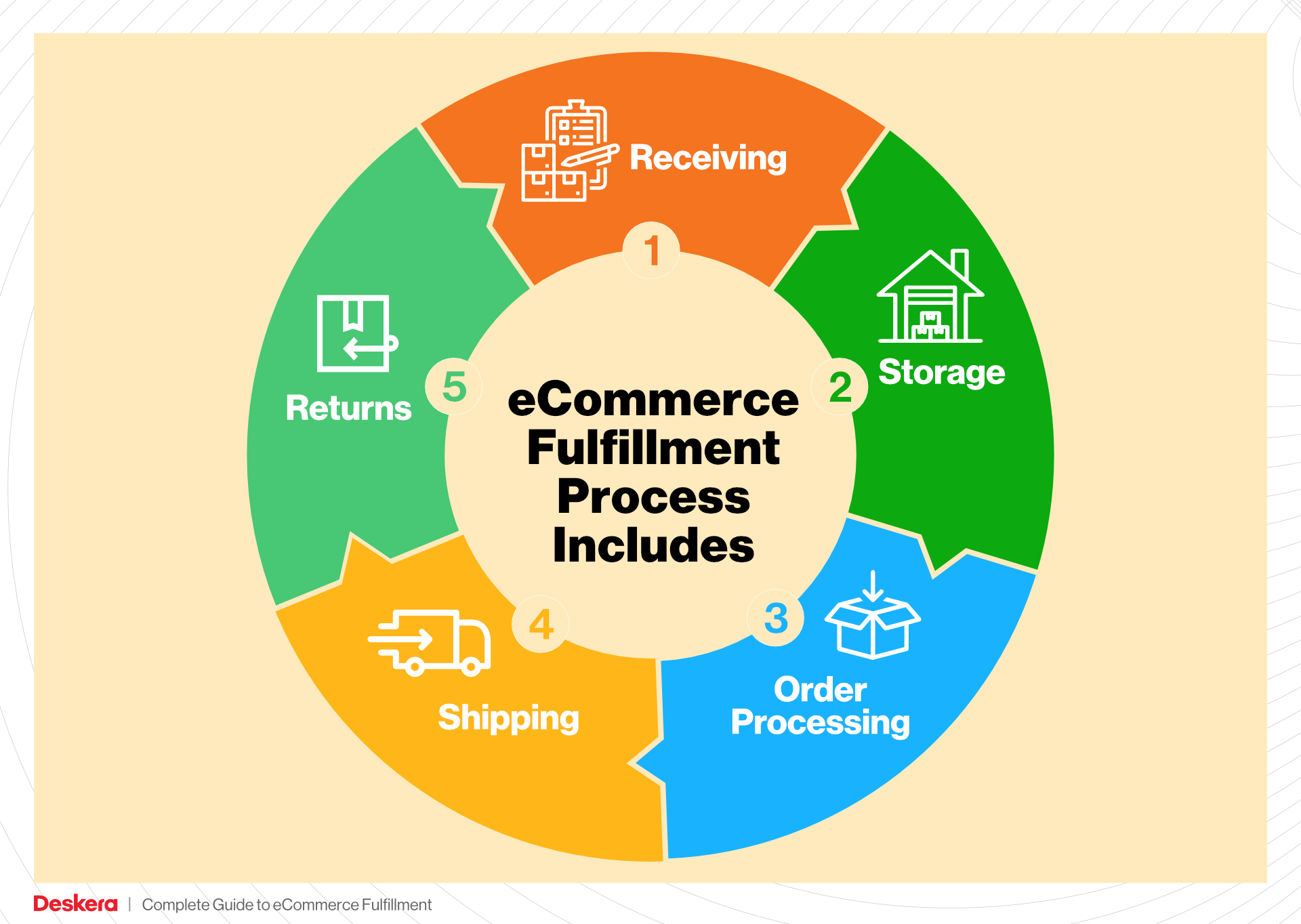
What You’ll Learn In This Guide
- What is E-commerce Fulfillment? An Introduction for Growing Businesses
- The Order Fulfillment Process: From ‘Buy’ Button to Customer’s Door
- Comparing Fulfillment Models: In-House vs. 3PL vs. Dropshipping
- A Deep Dive into Amazon FBA: Pros, Cons, and Who It’s For
- Core Services Offered by Fulfillment Centers
- How to Choose a Fulfillment Partner: A 6-Point Checklist
- Understanding Fulfillment Pricing: A Breakdown of Common Fees
- Frequently Asked Questions (FAQs) about Fulfillment
- Conclusion: Is Outsourcing Fulfillment the Right Move for Your Business?
- Important Disclaimer
The Order Fulfillment Process: From ‘Buy’ Button to Customer’s Door
1. Receiving Inventory
The first step in the order fulfillment process begins when inventory arrives at the fulfillment center. Upon receipt, each product is checked against the purchase order to ensure that the correct items and quantities have been delivered. This process involves the use of Stock Keeping Units (SKUs), which are unique identifiers assigned to each product. The SKU system enables efficient tracking of inventory and helps streamline the receiving process.
Proper inventory receiving is crucial for maintaining accurate stock levels and preventing discrepancies that can lead to stockouts or overstock situations. An efficient receiving process also sets the stage for smooth operations in subsequent steps. If inventory is not accurately recorded or if there are discrepancies, it can lead to delays, errors in order fulfillment, and ultimately, dissatisfied customers.
2. Warehouse Storage
Once inventory is received and verified, it must be stored in a manner that maximizes space and facilitates easy access for order picking. This is typically done through organized shelving, bins, or pallets, with items categorized by type, size, or demand frequency. Effective warehouse management systems (WMS) can automate and optimize the storage process, ensuring that items are placed in the most logical locations based on their expected order frequency.
The importance of this step cannot be overstated. Proper storage not only ensures that products are easily accessible for order fulfillment but also helps maintain an organized environment that reduces picking errors and speeds up the entire process. A well-structured storage strategy can significantly reduce picking time, thereby enhancing overall operational efficiency.
3. Order Picking
Order picking is the process of selecting items from the warehouse based on customer orders. This step can utilize various picking methods, such as single order picking, batch picking, or wave picking, depending on the volume of orders and the layout of the warehouse. A pick list, which details the items to be collected and their respective locations, is generated for the warehouse staff to follow.
This stage is critical, as the accuracy of order picking directly affects customer satisfaction. Errors in picking can lead to incorrect items being shipped, resulting in returns and additional shipping costs. Thus, implementing strategies like barcode scanning or mobile picking devices can enhance accuracy and efficiency. Additionally, optimizing pick paths—determining the most efficient route for picking items—can further streamline this process.
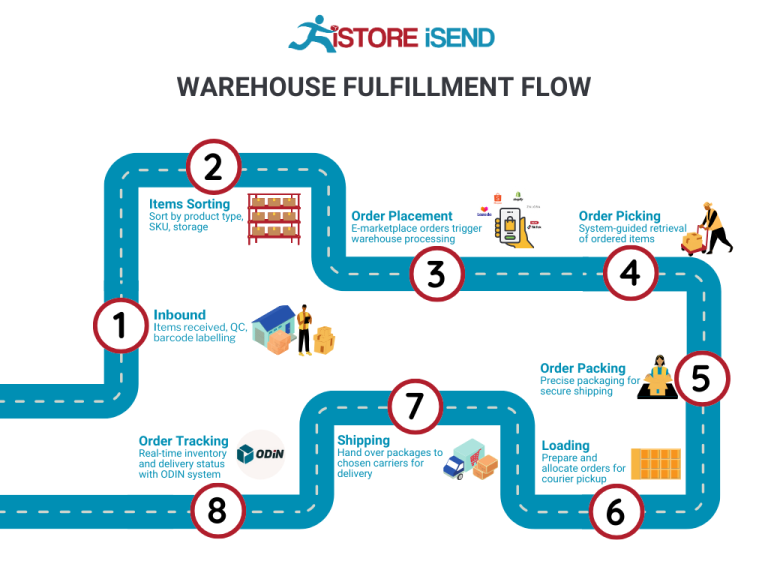
4. Order Packing
After items have been picked, they move to the packing station, where they are prepared for shipment. This involves checking the picked items against the order to ensure correctness, and then securely packing them to prevent damage during transit. Packaging materials and methods should be chosen based on the type of product being shipped, with considerations for environmental sustainability where possible.
Packing is a vital step because it protects the product and ensures it arrives at the customer’s location in perfect condition. Efficient packing processes can also reduce shipping costs by minimizing package size and weight. Proper training for staff on packing techniques and the use of packing slips—documents that accompany shipments detailing the contents—can further enhance the packing process and customer experience.
5. Shipping & Delivery
The final step in the order fulfillment process is shipping and delivery, which involves coordinating with logistics providers to ensure timely delivery to customers. This process includes selecting the most efficient shipping method and preparing shipping labels that include tracking information. The choice of carrier can impact shipping costs and delivery times, making it essential to evaluate options regularly.
Shipping is crucial as it is the last touchpoint between the business and the customer. Timely and accurate delivery can significantly influence customer satisfaction and loyalty. Moreover, providing tracking information enhances transparency and allows customers to monitor their orders, improving their overall shopping experience. Businesses should consider using advanced logistics software to optimize routes and manage shipping costs effectively.
In conclusion, mastering the order fulfillment process—from receiving inventory to delivering the final product—requires attention to detail at each step. By implementing best practices and leveraging technology, e-commerce businesses can enhance efficiency, reduce costs, and ultimately delight customers with a seamless shopping experience.
Comparing Fulfillment Models: In-House vs. 3PL vs. Dropshipping
Fulfillment Model Comparison
| Model | Who Handles Inventory | Best For (Business Stage) | Key Advantage | Key Disadvantage |
|---|---|---|---|---|
| In-House Fulfillment | Business itself | Established businesses with stable demand | Greater control over inventory and quality | High overhead costs and resource requirements |
| Third-Party Logistics (3PL) | 3PL provider | Growing businesses seeking scalability | Reduced operational burden and flexibility | Less control over inventory and processes |
| Dropshipping | Supplier | Startups and small businesses with limited capital | Low upfront investment and risk | Lower profit margins and reliance on suppliers |
In-House Fulfillment
In-house fulfillment involves a business managing its own inventory, warehousing, and order processing. This model is often favored by established companies with stable demand and a solid sales history. The primary advantage of in-house fulfillment is the level of control it affords over inventory management, quality assurance, and customer experience. Businesses can tailor their operations to meet specific customer needs and quickly respond to market changes. However, this model comes with substantial disadvantages. The overhead costs can be significant, as businesses must invest in warehouse space, technology, and personnel. Moreover, scaling operations can be complex, requiring additional resources and time to manage increased demand.
Third-Party Logistics (3PL)
Third-party logistics (3PL) providers take over the logistics and fulfillment processes for businesses. This model is particularly well-suited for growing businesses that need to scale efficiently without the burden of managing warehousing and fulfillment operations themselves. By outsourcing these functions, businesses can focus on core activities such as marketing and product development. A key advantage of using a 3PL is the reduced operational burden; these providers often have established systems and expertise that can lead to improved fulfillment speed and efficiency. However, businesses may experience a loss of control over inventory management and order fulfillment processes, which can lead to challenges in maintaining consistent quality and customer service.
Dropshipping
Dropshipping is a fulfillment model where retailers sell products without holding inventory themselves. Instead, when a retailer receives an order, they purchase the item from a third-party supplier who ships it directly to the customer. This model is particularly advantageous for startups and small businesses with limited capital since it requires minimal upfront investment in inventory. Retailers can offer a wide range of products without the risk of unsold inventory, making it an attractive option for testing new markets or products. However, dropshipping comes with its own set of challenges, including lower profit margins due to reliance on suppliers and potential delays in shipping. Additionally, the retailer has limited control over product quality and fulfillment speed, which can impact customer satisfaction.
Conclusion
Choosing the right fulfillment model is crucial for the success of an e-commerce business. Each model offers distinct advantages and disadvantages that must be weighed according to the specific needs and growth stage of the business. In-house fulfillment provides maximum control but at a higher cost, while 3PL allows for scalability with reduced operational burden. Dropshipping offers a low-risk entry point for new businesses but can lead to challenges in profitability and customer satisfaction. Understanding these dynamics will help business owners make informed decisions that align with their strategic goals.
A Deep Dive into Amazon FBA: Pros, Cons, and Who It’s For
What is Fulfillment by Amazon (FBA)?
Fulfillment by Amazon (FBA) is a service that allows e-commerce sellers to store their products in Amazon’s fulfillment centers. Amazon takes care of storage, packaging, and shipping, while also providing customer service and handling returns. This program is designed to simplify the logistics of running an online business, enabling sellers to leverage Amazon’s vast distribution network and customer base.
When a customer makes a purchase, Amazon picks, packs, and ships the product on behalf of the seller. The seller benefits from Amazon’s extensive logistics capabilities, which include advanced shipping options and access to Amazon Prime customers. This service is particularly advantageous for small to medium-sized businesses that may not have the resources to manage their own fulfillment operations.
How Does FBA Work?
-
Setup: Sellers create an Amazon seller account and enroll in the FBA program. They then prepare their products according to Amazon’s guidelines and ship them to Amazon’s fulfillment centers.
-
Storage: Once the products arrive at the fulfillment center, Amazon stores them until an order is placed. The seller is charged storage fees based on the space their products occupy.
-
Order Processing: When a customer orders a product, Amazon’s systems automatically pick, pack, and ship the item. The seller is notified of the sale and the fulfillment process.
-
Customer Service: Amazon handles all customer inquiries and returns related to FBA orders, providing a seamless experience for both the seller and the customer.
-
Payment: After the order is fulfilled, the seller receives payment from Amazon, minus any applicable fees for storage and fulfillment.
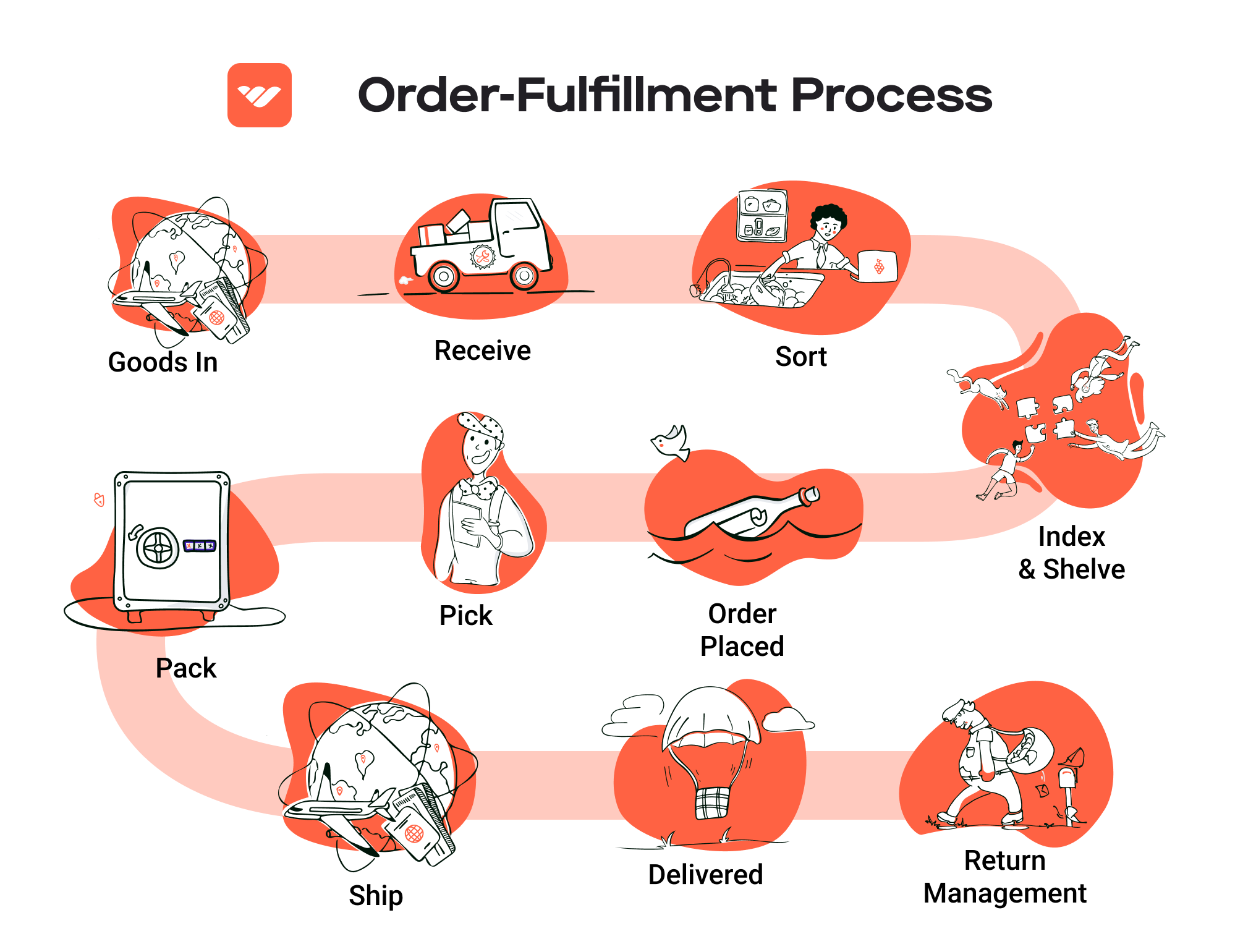
Pros of Using FBA
Prime Eligibility
One of the most significant advantages of using FBA is that products become eligible for Amazon Prime, which can dramatically increase visibility and sales. Prime members often prefer products that offer free two-day shipping, making FBA an attractive option for sellers looking to reach this audience.
Customer Trust
Selling through FBA can enhance customer trust. Since Amazon handles fulfillment, customers are more likely to feel confident in their purchase due to Amazon’s established reputation for reliability and quality customer service. This can lead to higher conversion rates and repeat business.
Multi-Channel Fulfillment
FBA allows sellers to fulfill orders from other sales channels, such as eBay or their own websites, using Amazon’s infrastructure. This multi-channel fulfillment capability enables sellers to streamline their operations, reducing the complexity of managing multiple inventory systems.
Scalability
FBA provides a scalable solution for growing businesses. As sales increase, sellers can easily send more inventory to Amazon without needing to invest in additional storage or logistics capabilities.
Cons of Using FBA
High Fees
FBA comes with various fees that can significantly eat into profit margins. These include storage fees, fulfillment fees, and long-term storage fees for items that do not sell quickly. Sellers must carefully calculate these costs to ensure that FBA remains profitable for their business.
Strict Inventory Rules
Amazon has strict guidelines regarding inventory management, including requirements for labeling and packaging. Sellers must adhere to these rules to avoid penalties, which can be time-consuming and cumbersome.
Commingling Risks
FBA uses a process called commingling, where products from different sellers are stored together. This can lead to issues if a customer receives a defective or counterfeit product that isn’t from the original seller. In such cases, the seller may face negative reviews and loss of customer trust, even if the issue was not their fault.
Loss of Control
By using FBA, sellers hand over a significant portion of their logistics to Amazon. This can lead to a loss of control over the fulfillment process, including inventory management, shipping times, and customer interactions.
Who is FBA Best For?
Fulfillment by Amazon is best suited for:
-
Small to Medium-Sized Businesses: Companies that lack the resources to manage their own fulfillment operations can benefit significantly from FBA’s streamlined logistics and infrastructure.
-
Brands Looking to Scale: Businesses aiming for rapid growth can leverage FBA to reach a broader audience without the burden of managing logistics in-house.
-
Sellers with High Sales Volume: Businesses that sell a high volume of products can absorb FBA fees more comfortably, making it a viable option to optimize fulfillment.
-
Those Seeking Prime Access: Sellers targeting Amazon Prime customers will find FBA essential for gaining visibility and credibility in a competitive marketplace.
In summary, Fulfillment by Amazon presents a compelling option for many e-commerce sellers, but it is essential to weigh the pros and cons carefully. Understanding your business model, sales volume, and target audience will help determine whether FBA is the right choice for you.
Core Services Offered by Fulfillment Centers
Inventory Management & Warehousing
Inventory management and warehousing form the backbone of any successful fulfillment center. This service involves the systematic tracking of inventory levels, orders, sales, and deliveries. Fulfillment centers utilize advanced inventory management systems that provide real-time data on stock levels, allowing e-commerce businesses to maintain optimal inventory levels and avoid stockouts or overstock situations.
The benefits of effective inventory management are manifold. First, it enhances cash flow by ensuring that capital isn’t tied up in excess inventory, which can lead to markdowns and losses. Second, it improves order accuracy, as fulfillment centers can quickly locate and allocate products, thereby reducing the chances of errors that can lead to customer dissatisfaction. Lastly, with accurate demand forecasting facilitated by sophisticated algorithms, businesses can make informed decisions about restocking, which ultimately supports better customer service and enhances brand loyalty.
Pick and Pack Services
Pick and pack services involve the process of retrieving items from warehouse shelves and preparing them for shipment. This service typically includes picking the correct items, packing them securely, and labeling them for delivery. Fulfillment centers use optimized picking methods, such as batch picking or zone picking, to streamline the process and reduce the time it takes to fulfill an order.
The primary benefit of pick and pack services is efficiency. By outsourcing this function, e-commerce businesses can focus on their core competencies, such as marketing and product development. Additionally, fulfillment centers often have the technology and systems in place to handle high volumes of orders, which can lead to faster turnaround times and improved shipping accuracy. This efficiency translates directly into customer satisfaction, as quicker processing and delivery times can significantly enhance the overall shopping experience.
Kitting and Assembly
Kitting and assembly services refer to the process of combining multiple products into a single package or kit before shipping. This service is particularly useful for e-commerce businesses that sell products that are often purchased together or that require assembly prior to delivery. For instance, a fulfillment center might assemble a furniture kit that includes various components like screws, tools, and instructions, or create gift bundles containing multiple items.
The advantage of kitting and assembly is that it allows businesses to offer customized or bundled products, which can increase average order value and enhance the customer experience. By offering pre-assembled kits, businesses can also reduce the complexity of inventory management, as fewer individual SKUs need to be tracked. Moreover, this service can lead to increased operational efficiency, as fulfillment centers can streamline the packing process for these kits, resulting in faster shipping times and lower labor costs.
Returns Management (Reverse Logistics)
Returns management, or reverse logistics, is a critical service offered by fulfillment centers that deals with the process of handling returned products. This service includes receiving returned items, inspecting them for quality, restocking them if they are in sellable condition, and managing the disposition of unsellable items. Effective returns management systems are essential for maintaining customer satisfaction and loyalty.
The benefits of robust returns management are significant. First, a seamless returns process enhances the customer experience, as consumers appreciate the ability to return items easily. This can be a decisive factor in a customer’s decision to purchase from a retailer, knowing they have the option to return products hassle-free. Secondly, efficient returns management can minimize losses associated with returned goods by quickly processing and restocking items that can be resold. Finally, fulfillment centers can analyze return data to identify trends and potential issues with products, allowing businesses to make informed decisions about inventory and product offerings in the future.
In conclusion, fulfillment centers provide a suite of core services that are essential for e-commerce businesses looking to scale effectively. By leveraging inventory management, pick and pack services, kitting and assembly, and returns management, businesses can enhance operational efficiency, improve customer satisfaction, and ultimately drive sales growth. Investing in these services is not just about logistics; it’s about creating a streamlined, responsive supply chain that supports the evolving needs of modern consumers.
How to Choose a Fulfillment Partner: A 6-Point Checklist
Location & Warehouse Network
Importance: The geographical location of your fulfillment partner’s warehouses can significantly impact shipping times and costs. A partner with a strategically placed network can reduce delivery times and enhance customer satisfaction.
Questions to Ask:
– How many warehouses do you operate, and where are they located?
– Can you provide insights into your average shipping times for various regions?
– What is your strategy for expanding your warehouse network in the future?
– Do you have fulfillment centers that are specifically optimized for urban or rural deliveries?
Technology & Integrations
Importance: In today’s e-commerce landscape, technology plays a vital role in the efficiency of fulfillment operations. A partner that uses advanced technology can provide real-time tracking, inventory management, and seamless integrations with your existing systems.
Questions to Ask:
– What fulfillment management systems do you use, and how do they integrate with e-commerce platforms like Shopify, WooCommerce, or Magento?
– Can you provide real-time inventory updates and order tracking capabilities?
– How do you handle returns and exchanges through your technology?
– What measures do you have in place to ensure data security and compliance with regulations like GDPR?
Specializations (e.g., Cold Storage, Oversized Items)
Importance: Depending on your product type, you may need a fulfillment partner with specific capabilities, such as cold storage for perishables or specialized handling for oversized items. Understanding their specializations can help you avoid costly mistakes.
Questions to Ask:
– What types of products are you equipped to handle?
– Do you have specialized facilities for handling items that require temperature control or oversized packaging?
– Can you manage complex inventory needs, such as custom kitting or bundling?
– What experience do you have with businesses in my industry?
Scalability & Capacity
Importance: As your business grows, your fulfillment partner must be able to scale with you. A partner with adequate capacity can accommodate seasonal spikes in demand without sacrificing service quality.
Questions to Ask:
– What is your current capacity for handling orders, and how do you manage peak seasons?
– How do you plan to accommodate future growth or fluctuations in demand?
– Can you provide case studies or examples of how you’ve managed scaling for past clients?
– What processes do you have in place to ensure that service levels remain consistent during high-demand periods?
Pricing and Contracts
Importance: Understanding the pricing structure and contract terms is crucial for maintaining healthy profit margins. Transparent pricing can help you avoid unexpected costs down the line.
Questions to Ask:
– Can you provide a detailed breakdown of your pricing model, including shipping, handling, and storage fees?
– Are there any hidden fees or minimum order requirements?
– What are the contract terms, and how flexible are they?
– How often do you review and adjust pricing, and under what circumstances?
Customer Support & Reviews
Importance: Excellent customer support is essential for resolving issues swiftly and maintaining a strong partnership. Additionally, reviewing a partner’s reputation can provide insights into their reliability and service quality.
Questions to Ask:
– What kind of customer support do you offer (e.g., dedicated account manager, 24/7 support)?
– How do you handle customer complaints or issues that arise during the fulfillment process?
– Can you provide references or case studies from current or past clients?
– What is your average response time for customer inquiries or issues?
Conclusion
Choosing the right fulfillment partner is a critical decision that can significantly impact your e-commerce operations. By using this checklist, you can assess potential partners on various important criteria, ensuring that you select one that aligns with your business goals and can support your growth. Remember, the right partner will not only help you streamline your fulfillment processes but also enhance your customer experience, ultimately driving your business success.
Understanding Fulfillment Pricing: A Breakdown of Common Fees
Initial Setup Fees
Initial setup fees are one-time charges incurred when you first engage with a fulfillment center. These fees can vary widely depending on the complexity of your operations and the specific requirements of your business. Common components of initial setup fees may include account setup, integration of your e-commerce platform with the fulfillment center’s systems, and potentially any necessary customizations to accommodate your product types.
To calculate these fees, fulfillment centers may consider factors such as the number of SKUs (stock keeping units) you have, the complexity of your inventory management needs, and the technology integrations required. It’s crucial to clarify what is included in these fees to avoid unexpected costs later on.
Receiving Fees
Receiving fees are charged for the process of accepting your inventory into the fulfillment center. This fee typically covers the labor and resources required to unload, inspect, and store your products. Receiving fees can be calculated based on the volume of inventory received, often charged per pallet or item.
For example, if you send a shipment containing 10 pallets, you might incur a receiving fee for each pallet. Some fulfillment centers may also charge for additional services, such as labeling or quality checks during the receiving process. It’s advisable to inquire about these specifics to understand the total potential costs.
Storage Fees (per pallet/bin)
Storage fees are ongoing charges for keeping your inventory in the fulfillment center. These fees are usually calculated on a monthly basis and can be charged per pallet, bin, or square foot, depending on the storage method used by the fulfillment center.
The fee structure can vary significantly based on the type of products being stored. For example, seasonal or oversized items may incur higher storage fees. It’s important to evaluate your inventory turnover rates, as a higher turnover can help minimize these costs. Additionally, some fulfillment centers offer tiered pricing based on the volume of inventory stored, so it’s worth discussing potential discounts for larger quantities.
Pick & Pack Fees (per item/order)
Pick & pack fees cover the labor involved in selecting (picking) items from storage and packing them for shipment. This fee is typically calculated per item or per order, depending on the fulfillment center’s pricing model.
The complexity of the picking process can influence these fees; for instance, a multi-item order may incur higher pick fees than a single-item order due to the additional labor involved. Some fulfillment centers also charge for packing materials, such as boxes and bubble wrap. To manage these costs, it’s advisable to review your order patterns and discuss with the fulfillment center about optimizing packing methods, which can lead to cost savings.
Shipping Fees
Shipping fees are incurred for transporting your orders to customers. These fees can be one of the most variable components of fulfillment pricing, as they depend on factors such as the destination, shipping method (standard vs. expedited), and the weight and dimensions of the package.
Fulfillment centers often negotiate shipping rates with carriers and may pass these savings on to you. However, it’s essential to clarify whether these rates are included in your overall fulfillment pricing or charged separately. Understanding the shipping options and their associated costs can help you make more informed decisions about how to fulfill orders efficiently and cost-effectively.
Tips for Getting an Accurate Quote
-
Be Transparent About Your Needs: Provide detailed information about your product types, inventory levels, and expected order volumes. The more information you give, the more accurate the quote will be.
-
Request a Breakdown of Fees: Ensure you receive a detailed breakdown of all potential fees, including any additional services that may incur charges. This can prevent surprises later.
-
Inquire About Discounts: Ask about volume discounts or bundled services that can lower overall costs. Many fulfillment centers are willing to negotiate based on your projected order volume.
-
Consider Seasonal Fluctuations: If your business experiences seasonal peaks, discuss how these fluctuations will affect storage and shipping costs, and whether the fulfillment center offers scalable solutions.
-
Assess Technology Integration: Ensure that the fulfillment center can seamlessly integrate with your existing e-commerce platform. Inquire about any potential costs associated with this integration.
By understanding these common fulfillment pricing models and following these tips, you can better navigate the complexities of fulfillment fees and make informed decisions that support your business growth.
Frequently Asked Questions (FAQs) about Fulfillment
1. What is the purpose of a fulfillment center?
A fulfillment center is a specialized facility that manages the storage, packaging, and shipping of products for e-commerce businesses. It serves as a central hub where inventory is kept, orders are processed, and logistics are coordinated, allowing businesses to efficiently deliver products to customers.
2. How does Urban Outfitters’ fulfillment center operate?
Urban Outfitters’ fulfillment centers utilize advanced logistics and inventory management systems to optimize order processing. They leverage data-driven strategies, such as algorithms developed by Celect, to determine the most efficient shipping locations, reducing lost sales and shipping costs while ensuring that inventory levels meet demand across various sales channels.
3. What is the difference between a warehouse and a fulfillment center?
While both warehouses and fulfillment centers store products, their functions differ significantly. A warehouse primarily focuses on long-term storage and inventory management, whereas a fulfillment center is designed for quick processing and shipping of orders. Fulfillment centers are equipped to handle order picking, packing, and shipping with speed and efficiency, catering specifically to e-commerce needs.
4. What is a 3PL (Third-Party Logistics)?
A 3PL is a service provider that manages logistics and supply chain functions for businesses. This includes warehousing, order fulfillment, transportation, and inventory management. By outsourcing these functions to a 3PL, businesses can focus on their core operations while leveraging the expertise and resources of the 3PL to enhance efficiency and reduce costs.
5. How much do fulfillment services cost?
Fulfillment service costs can vary based on several factors, including the volume of orders, storage requirements, packaging needs, and shipping destinations. Generally, costs may include a per-order fee, storage fees, and shipping charges. It’s essential for businesses to evaluate their specific needs and compare pricing models from different fulfillment providers to find a solution that fits their budget and operational requirements.
6. What technologies are used in Urban Outfitters’ fulfillment centers?
Urban Outfitters employs a range of technologies in its fulfillment centers, including inventory management software, automated picking systems, and data analytics tools. These technologies help streamline operations, improve accuracy in order processing, and enhance overall efficiency in logistics management.
7. How does Urban Outfitters ensure quality control in their fulfillment process?
Quality control at Urban Outfitters involves several measures, including regular inspections of inventory, quality checks during the packing process, and feedback loops that incorporate customer returns and complaints. Their specialized teams, such as inspection clerks and quality assurance personnel, work diligently to maintain high standards for product quality.
8. Can small businesses use Urban Outfitters’ fulfillment services?
While Urban Outfitters primarily serves its own retail operations, small businesses can benefit from similar fulfillment services offered by third-party logistics providers. Many 3PLs cater specifically to small and medium-sized enterprises, providing scalable solutions that can adapt to the growth and needs of smaller e-commerce businesses.
9. What role does data play in Urban Outfitters’ fulfillment strategy?
Data is critical in Urban Outfitters’ fulfillment strategy. It is used for demand forecasting, inventory management, and optimizing shipping routes. By analyzing customer purchasing patterns and inventory levels, Urban Outfitters can make informed decisions that enhance efficiency, reduce costs, and improve customer satisfaction.
10. How can businesses improve their fulfillment operations?
To improve fulfillment operations, businesses should focus on optimizing inventory management, leveraging technology for efficiency, and continuously analyzing their logistics processes. Implementing a robust fulfillment strategy that includes data analytics, choosing the right fulfillment partner, and maintaining clear communication across the supply chain can lead to significant improvements in order accuracy, speed, and overall customer experience.
Conclusion: Is Outsourcing Fulfillment the Right Move for Your Business?
Evaluating the Benefits of Outsourcing Fulfillment
Outsourcing fulfillment can be a game-changer for e-commerce businesses looking to scale. One of the most significant advantages is the time savings it provides. By delegating logistics and order processing to a third-party fulfillment center, you can focus on core business activities such as product development, marketing, and customer engagement. This shift in focus allows for more strategic decision-making and can lead to increased revenue growth.
Scalability is another crucial benefit. As your business grows, so do your fulfillment needs. A reliable fulfillment partner offers the capacity to handle increased order volumes without the headaches of managing additional infrastructure or hiring new staff. This flexibility enables you to respond to market demands swiftly, ensuring you can capitalize on sales opportunities, especially during peak seasons.
Moreover, partnering with an experienced fulfillment service brings specialized expertise to your operations. These providers often have advanced technology, optimized processes, and industry insights that can enhance efficiency and reduce costs. For instance, companies like Urban Outfitters have successfully utilized sophisticated algorithms to optimize shipping routes and inventory management, minimizing lost sales and shipping expenses.
However, it is imperative to choose the right fulfillment partner. The ideal partner should align with your business goals, possess a robust infrastructure, and offer transparent communication. A poor choice can lead to inefficiencies that may counteract the benefits you seek.
Next Steps: Audit Your Shipping Process
Now is the time to evaluate your current shipping and fulfillment processes. Conduct an audit to identify bottlenecks, inefficiencies, and areas for improvement. Ask yourself: Is your current system scalable? Are you leveraging technology effectively? By answering these questions, you can determine if engaging a fulfillment partner is the right strategic move for your business’s growth.
Important Disclaimer
⚠️ Important Disclaimer
The information in this guide is for educational purposes. Fulfillment services, pricing, and platform features change frequently. Always conduct your own due diligence and consult with providers directly before making business decisions.
